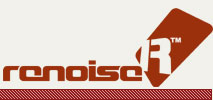Scopes / DiskOp
This part of the screen has two main functions. Firstly, it displays audio visualizations, and secondly,
it contains a 'disk browser' for operations such as loading/saving of songs, samples, instruments,
patterns, tracks, and themes (skins).
Scopes section
Scopes show the resulting waveform of the current channel or track that is playing,
or frequency analysis. They are used to monitor song or track state.
Active track and visible range on Track Scopes is highlighted.
You can also choose to display only track numbers instead of track names in the
Configs menu.
Spectrum shows spectral analysis of song (most dominant frequencies in range
from 20 to 20000 Hz).
In Track Scopes mode you can mute/unmute tracks by clicking the left mouse button on the track,
and solo/unmute all tracks with a right click.
Screen displays (from top-left to bottom-right)
Stereo Scopes
Switch to 2 scopes visualization, one for each stereo channel.
The stereo scopes are sensitive to the master volume (unlike the track scopes),
so this is the place to go if you need to "see" clicks or distortion.
Track Scopes - Switch to track scopes visualization, one for each track.Spectrum
Switch to spectrum analyzer visualization, shows frequency analysis
for all tracks.Width
Adjusts window width for scopes (range of the sample values displayed
in each scope) or bar width in spectrum mode.DiskOp
Switch to DiskOp window (replaces Scopes window).
DiskOp
The DiskOp section is used for everything that concerns finding, loading,
renaming, and saving of files, creating or deleting of directories
etc.
Previewing (i.e. listening to) a sample while it is loading also applies
any current track effects so you can hear exactly what you would hear
if you used that sample as an instrument in the current track.
Please notice that the new diskop remembers the current directory
for each filetype seperately. So, if you choose d:\something while
you are in Song mode, next choose e:\foo\bar in Instrument mode and
switch back to Song mode, d:\something will be restored.
Clicking with the right mousebutton on a directory in the left tree-view
will make the selected directory the new root-entry. Clicking a File
with the right mousebutton will load it instantly. This is pretty
useful for browsing samples since you dont have to torture your mouse
with insane doubleclicks.
Screen displays (from top-left to bottom-right)
Favorites
Here you can store your favorite directories for the categories
"Song", "Track", "Instrument", "Sample", and "Skin". By clicking
with the right mouse button you save a directory,
by clicking with the left one you load/restore it.
So you have 4 * 5 Favorite slots. (4 slots for 5 filetypes)Arrow up/down
Clicking on these arrows takes you one directory level up or down.Directory buttons with arrows
This lists the disk drives currently found on
your system. Click on a drive letter to enter it or scroll through the list by clicking
on the up or down arrow.Directory and file structure
This window shows you the files and directories currently
found on the selected hard drive. On the right side of it, you see a scrollbar. Use it
to scroll down or up.Window of found files
This window lists the files of the selected type found in
the current directory.*.*
Click this button to show all files found in the current directoy, not only
the ones of the selected type.(Headphones)
This button defines whether you prelisten to samples you load into
your song.(Circle with arrows)
This button refreshes the directory listing."+ (directory)"
Creates a new (sub)directory. To do so, click on the button,
enter a name in the popup window and click "Create".A
Renames files and directories. To do so, click on the button, after that click
on a file or directory you want to rename, enter the new name in the popup window
and click "Rename".(Trashcan)
Deletes files and directories. To do so, click on the button and after
that click a file you want deleted.Save
This is the button that saves the currently selected file type. Enter a name
in the bar on the right side of it first. Overwriting a file causes a popup window
asking for your confirmation to do so.
Also note that saving a song also saves the cursor position and instrument that was
last used so you can continue exactly where you left off.
Back to the top!




